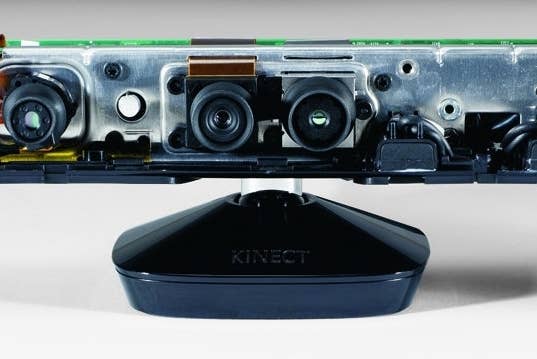Durango Kinect 2.0 specs leak
Increased resolution, lower lag, new IR sensor for better low-light performance
VGLeaks is at it again, posting a lengthy document on the specs and capabilities of Kinect 2.0 - the depth camera and motion sensor said to be bundled with the next generation Xbox, codenamed Durango.
"There are no earth-shattering surprises from the leak: it's an evolution of the existing system that addresses most of the flaws of the original sensor, but not fully resolving lag or depth resolution issues."
The headline improvements suggested by the leak see an improvement in resolution from both the colour and depth cameras with the introduction of a third sensor allowing Kinect to access the infra-red spectrum, effectively allowing Durango to offer much-improved performance in low-light scenarios. The Kinect interface moves from the USB 2.0 interface to USB 3.0, with end-to-end latency measurements dropping from the older sensor's 90ms down to 60ms.
Boosts elsewhere show clear improvements over the current sensor. The 640x480 RGB camera is upgraded to a more impressive 1080p (with a move from 24-bit RGB colour to a more manageable 16-bit YUV set-up), while depth resolution improves from 320x240 to 512x424. The actual amount of depth being measured (from 40cm away from the camera to a maximum of four metres) remains the same, but field of view is opened up significantly to the point where the tilt sensor on the older Kinect is no longer required on its mooted successor. The leak's author reckons that there'll be less calibration required, and that the system can work around furniture - gamers won't need to re-arrange their living rooms for a quick bout of Kinect gaming.
Improvements to the quality of the data harvested from Kinect are also mooted via the inclusion of an infra-red sensor: "The active IR stream is stable across variable lighting conditions," says the leaked document. "For example, shadows, pixel intensities and noise characteristics are the same for a well-lit room, the same as for no light in the room. As a result, this stream could be used for feature detection in situations where a color stream would be useless."
| Kinect for Xbox 360 | Durango Kinect | |
|---|---|---|
| Field of View (FOV) | 57.5˚ horizontal by 43.5˚ vertical | 70˚ horizontal by 60˚ vertical |
| Resolvable Depth | 0.8m to four metres | 0.8m to four metres |
| Color Stream | 640x480x24bpp 4:3 RGB @ 30fps/ 640x480x16bpp 4:3 YUV @ 15fps | 1920x1080x16bpp 16:9 YUY2 @ 30 fps |
| Depth Stream | 320x240x16bpp, 13-bit depth | 512x424x16bpp, 13-bit depth |
| Infrared (IR) Stream | - | 512x424, 11-bit dynamic range |
| Registration | Color/depth | Color/depth and active IR |
| Audio capture | 4-mic array returning 48KHz audio | 4-mix array returning 48KHz audio |
| Data Path | USB 2.0 | USB 3.0 |
| Latency | ~90 ms with processing | ~60 ms with processing |
| Tilt Motor | Vertical | - |
The document also hints at other elements of the Durango design. Significant OS resources are kept aside in order to run Kinect across multiple applications that operate simultaneously, while skeletal tracking has been improved significantly - people remain tracked if they are in profile with the camera, up to six players are supported with the wider field of view, standing and seated gameplay is properly implemented and while individual fingers can't be tracked, the new Kinect judges the difference between open and closed hands. Small children over a metre tall can also be tracked, apparently.
There's no big, earth-shattering takeaway from this leak and assuming it is accurate, it's safe to say that no major promises are being made that will fundamentally change the basic nature of current Kinect gameplay. It's an evolution of the existing system that addresses most of the fundamental flaws of the original sensor, but doesn't fully resolve some of them - latency and granularity of the data are improved, but still not perfect: features such as individual finger-tracking don't make the cut, for example. Dropping end-to-end lag from 90ms to 60ms is a good achievement, but you'll still 'feel' it; according to our information, the wireless controller on the Xbox 360 features a much lower 8ms of latency. It's worth bearing in mind that the plan is to bundle Kinect with every console, so the device will need to be cheap to manufacture. With that in mind, the improvements being suggested are probably rather good bearing in mind the budget available.
And so, having assessed the data, we find ourselves facing the usual question - how accurate is this leak and can it be trusted? We have confirmation from two sources now that the previous VGLeaks Durango post is effectively a cut-and-paste from one of a range of documents issued last year to developers by Microsoft's advanced technology group - the creators of Xbox hardware and dev tools. The detail is also a match for next-gen Kinect specs provided to Kotaku by arch-leaker, fanboy baiter - and now alleged FBI takedown victim - SuperDaE. We'll look into independently verifying this leak, but our immediate gut feeling is that this probably isn't a fake, though the data may be old. The kind of information being presented is beyond the vista of all but the most technologically aware (including an in-depth explanation of chroma sub-sampling would be a new height of sophistication for a hoax) while some of the data presented about the original camera would only be known by those with access to the original Kinect whitepapers, elements of which are not in the public domain, but which we know to be accurate.

